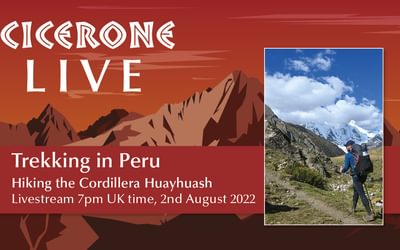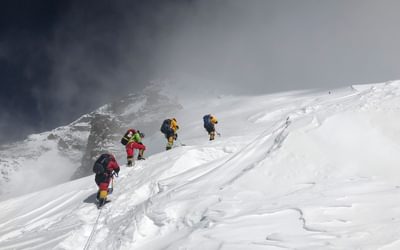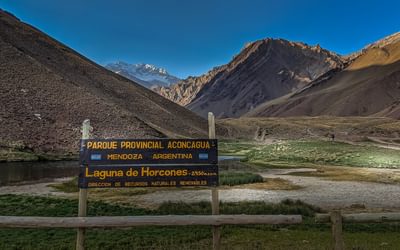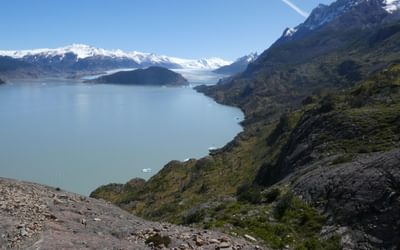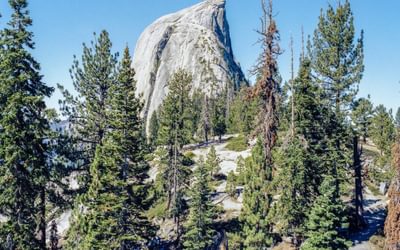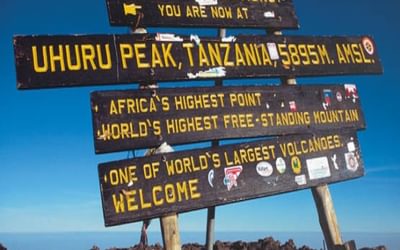Aconcagua – a taste of the big mountains
A reputation for ugliness is not the greatest accolade for a mountain to have. What brings people to Aconcagua (6962m) is its status as the highest mountain in South America, the highest peak in the western hemisphere and one of the Seven Summits. It's a shame, however, to reduce any mountain to statistics, to a summit bagged and ticked off a list before moving on to the next. Expedition leader Becky Coles describes the challenges of high altitude trekking.
Last November I headed out to Aconcagua to lead two expeditions there. I felt mild trepidation but, as I discovered, this mountain is easy to underestimate.
I arrived in Argentina at the very start of the season on Aconcagua. Throughout 2015 El Niño had been particularly strong, and so winter had lingered in the High Andes. It was cool in Mendoza as we visited hire shops to supplement the team's gear in preparation for the unusually cold conditions. An afternoon's drive away snow lingered in pockets by the closed pistes at Los Penitentes, a ski resort and staging post for those bound for Aconcagua.
Preparing for the ascent
When tackling the Normal Route it is possible to see the summit almost from the park gate, a further 20mins drive from Los Pentitentes. Seeing the mountain so early on is a double-edged sword: it’s great to see the objective from Day One of an expedition, but the view also has the potential to intimidate. It’s not possible to trick the mind into thinking you're just on a pleasant trek.
Members of an Aconcagua expedition have not typically been to such altitudes before, possibly not even 6000m. They are not all climbers as such, as the route doesn't demand technical climbing: many are likely to be keen hill walkers with experience on trekking peaks, and have often climbed Kilimanjaro. Aconcagua is not just higher than Africa’s highest peak: the weather is harsher, and the ability to look after oneself in high camps can be critical to success. It is naïve to think that you simply need to be fitter to summit such a mountain, that it is just an extension of a StairMaster workout.
Having considered the subtleties of success over failure on a mountain such as Aconcagua, I believe that physical fitness is only one of four key elements which contribute to a person summiting. The second, but equally important, element key to success is mental toughness: you need a willingness to suffer, an ability to take one day at a time and not be overwhelmed by the enormity of the challenge ahead. Thirdly, of equal importance is the ability to look after oneself at high altitude, to stay well and give the body every chance to acclimatise. And finally, luck: luck is as important as fitness, mental toughness and the ability to look after oneself. It is what every mountaineer needs, no matter what they climb.
Tackling Aconcagua
On one of the first acclimatisation days it is possible to walk from Confluencia Camp to a viewpoint from where the grandeur of the South Face rises up before you. The mountain looks imposing and hostile here, with thin veins of ice linking snowfields and hanging glaciers.
It's worth spending several nights in Confluencia to be well acclimatised before tackling the walk to base camp at Plaza de Mulas. This day involves a 17km trek with 800m of ascent. After initially dropping to the river junction which gives Confluencia camp its name, a short climb out the other side of the gorge gives way to a wide, flat valley. The Playa Ancha stretches out of sight; dusty and barren, it typifies the Aconcagua landscape. Starting early is advisable as by lunchtime a headwind intensifies, making for tough going.
The route finally starts to climb through undulating moraines before delivering a cruel finale as the trail rears up, zig-zagging its way through the steepest moraines yet to where base camp is hidden from the view of weary climbers.
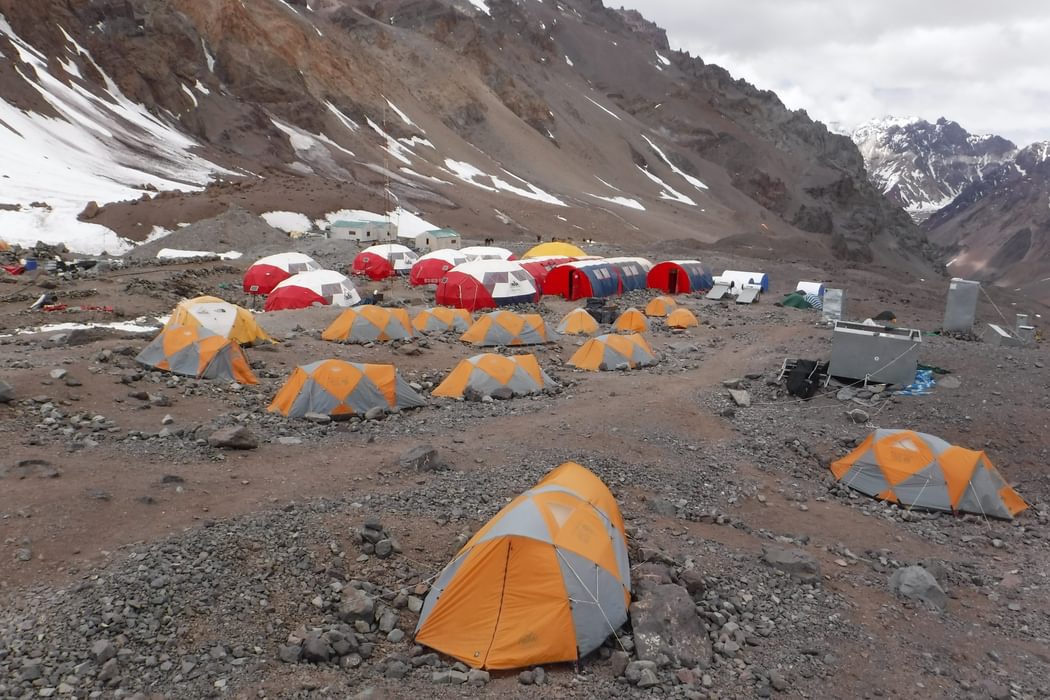
From base camp, once people have caught their breath and can face thinking about the climb ahead, it is possible, for the first time, to see the majority of the route to the summit. Despite the non-technical nature of the route it is evident from here that respect will be needed if a team is to succeed.
Argentine culture is orientated around family, and a family atmosphere prevailed among the staff, guides and climbers during our stay at base camp. Pablo, the base camp manager, crushed each of our hands on arrival and briefed us on the base camp facilities (and optional extras, such as showers and beers).
This year, for the first season ever, a mobile phone provider had installed a mast which transmits 4G phone reception across the camp – remote base camp is not, but comfortable it certainly is. We quickly became accustomed to steak with Malbec for dinner in our insulated and carpeted dining tent.
Sat beneath the summit, acclimatisation could now start in earnest. As we climbed high and slept low Aconcagua looked down on us, judging our progress, while we looked back. We watched for the build-up of lenticular clouds that can hang in layers over her top, and indicate the notoriously extreme winds of the High Andes. Some nights I lay in my tent to hear a foreboding roar building and tumbling down the mountain’s flanks, before the tent pressed itself against my face.
The blue of the sky was the deepest it had been yet when we made an ascent of Bonete Peak (5051m), which gives views not only across Chile but of the entire route up Aconcagua. From this viewpoint, without the need to crane our necks to see the highest reaches of the mountain, the route was no longer foreshortened and the huge mass of Aconcagua revealed itself. Having struggled up the much smaller Bonete Peak, seeing this isn't always the best motivation for the team.
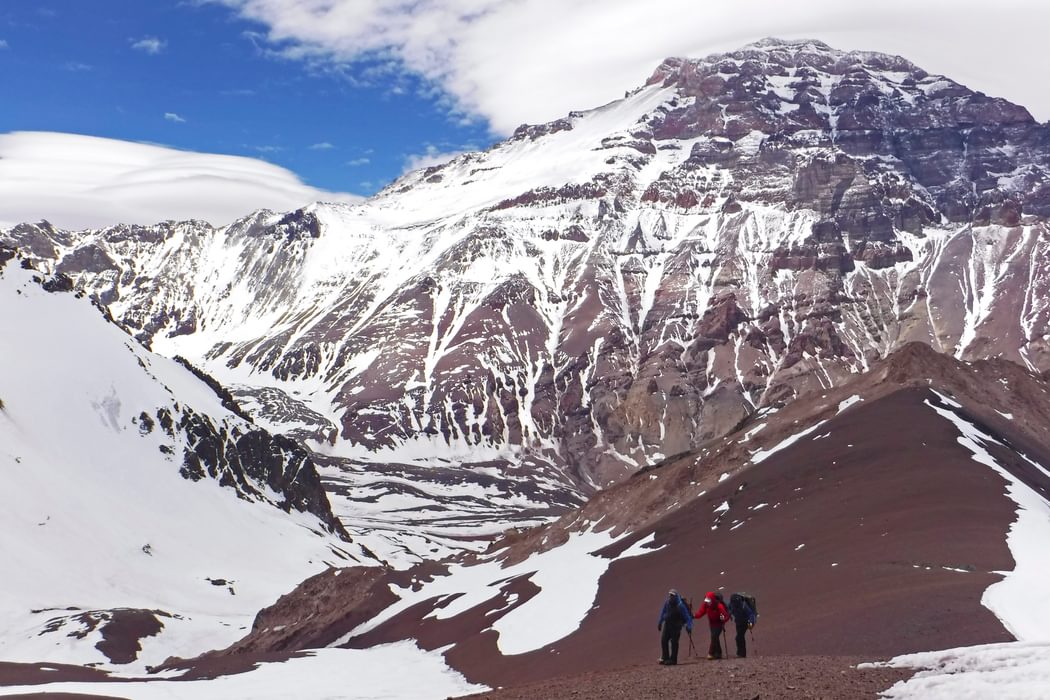
Rest days in base camp were followed by the expedition progressing on to load carries. Visiting Canada Camp (Camp 1) with loads on one day and Nido de Condores (Camp 2) on another was when we began to feel the mountain flexing her muscles, demanding to be handled with care. Snow fell around us on our final rest day at base camp, and the team's scheduled sock washing day was thrown into disarray as team members retreated into their tents to count whether they had enough clean pairs for our summit attempt.
It wasn't necessarily a bad thing that it had been particularly cold and snowy on the mountain and winter had been drawn out in the High Andes, as I prefer walking in crampons than on scree. The high camps, however, were brutally cold and the weather windows fleeting.
Scrutinising weather forecasts became an obsession. It wasn't looking good for our ascent but from base camp, with a rest day at Nido de Condores (Camp 2), it would be five days before we could make an attempt at the summit. This was too far ahead to get an idea of what the weather would actually be doing on summit day, so I prepared the team to leave the next day.
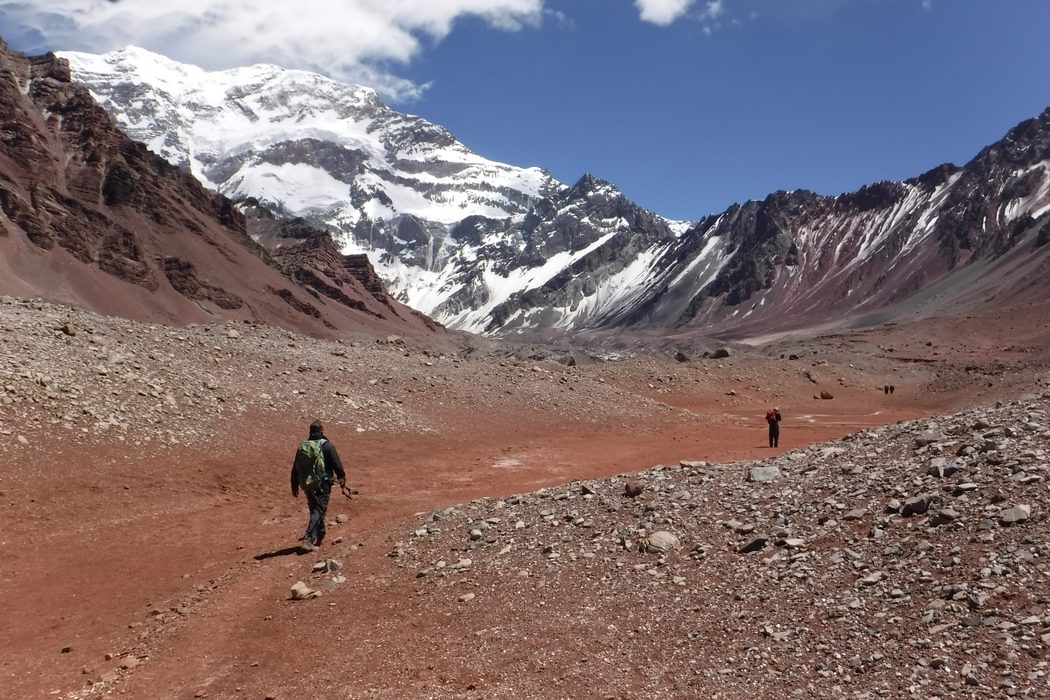
With apprehension we set off up the steep scree path which rose up the mountainside from almost out of our dining tent door. Zig-zagging across the scree slopes we passed Conway Rocks – which had become familiar as a rest stop during our acclimatisation phase – before the final rise into Canada Camp.
An additional advantage of the snowy weather was that there were no difficulties getting water at Canada Camp: in previous years this had been a major logistical challenge on the mountain. We set up tents, re-hydrated and ate a meal cooked by our local guides. Bathed in evening sunlight, we settled into our first high camp for the evening.
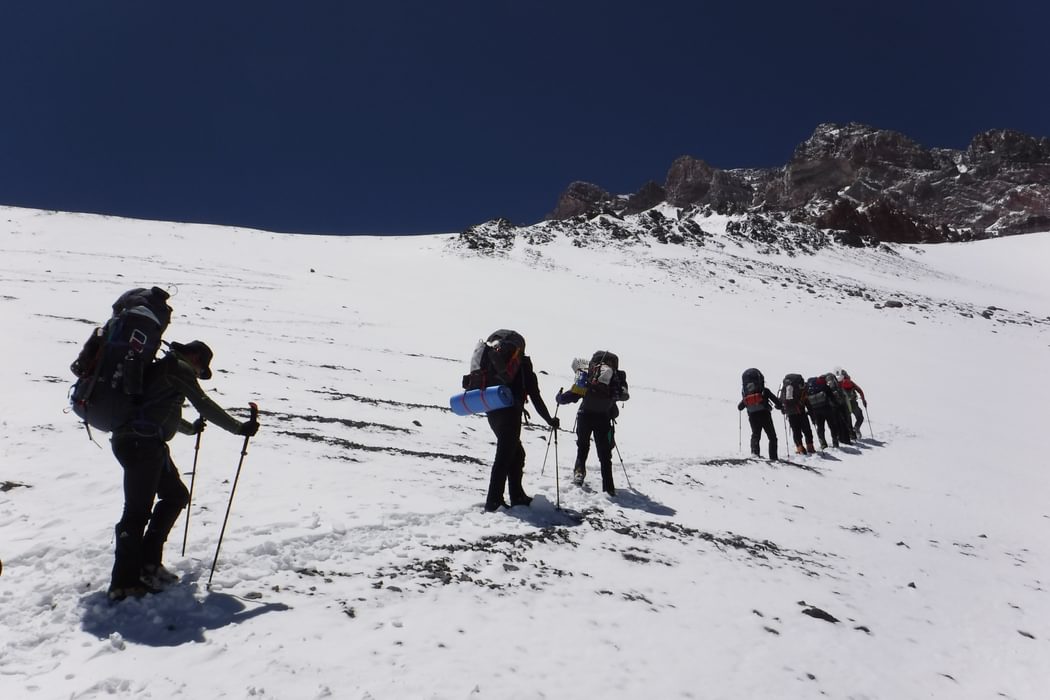
Aconcagua and the Southern Andes
Horcones Valley (Normal) and Vacas Valley (Polish Glacier) ascent routes
£16.95
Guidebook to climbing Aconcagua in Argentina. With descriptions for the Normal route (taking 12 days) or the Vacas Valley route (14 days). The treks cover difficult mountain terrain up to 6962m and are suitable for experienced walkers and mountaineers. Also features other treks in the southern Andes, including the Vallecitos and Tupungato ranges.
More informationMoving up the mountain the following day it's not unusual for bodies to start complaining and minds to start questioning. Focusing on the next step and not the days ahead is important now. To add to a tough day the weather started to close in. By the evening it was snowing hard and the wind steadily built to gale force. The next day was a rest day in the itinerary, but either way there was no chance of us progressing up the mountain. The wind picked up the loose, fresh snow and flung it around the camp, creating blizzard conditions. It was bitterly cold, and no matter how efficiently we got in and out of our tents it was impossible for the tent not to be filled with snow.
We spent another day sitting out the weather. Conditions such as these can be more wearing than the climbing itself, and are often underestimated by those who have not experienced it before. Looking after oneself, keeping the calories going in and fluid levels up is hard work, but without keeping busy doing this apathy takes hold and it is impossible to keep going, both mentally and physically. On this day three people in the team made the decision to descend.
It wasn't looking hopeful for a summit attempt: the winds were forecast to be high and, combined with the low temperatures, the wind chill brought the risk of frostbite. We moved up to Colera Camp (Camp 3) anyway: it was safe to do this and pushing a bit higher would at least give of the team a new personal best altitude.
The cold, dry air nipped at exposed skin. I helped the local guides cook and serve dinner to everyone that evening. The forecast was marginally better for the next day, with the winds due to be manageable in the morning, returning later in the day. It was the slimmest of chances, but at least she'd given us a chance.
On every other big mountain I've climbed an early start is obligatory on summit day, but here we opted for a later start. This gave us fewer hours to reach the summit, but meant we didn't have hours of trudging in the frigid pre-dawn.
We were out of our tents and moving as weak sunlight stretched towards us. Several teams were ahead, and we were the last to leave the camp. Had I made the right call or had I jeopardised the team's summit attempt?
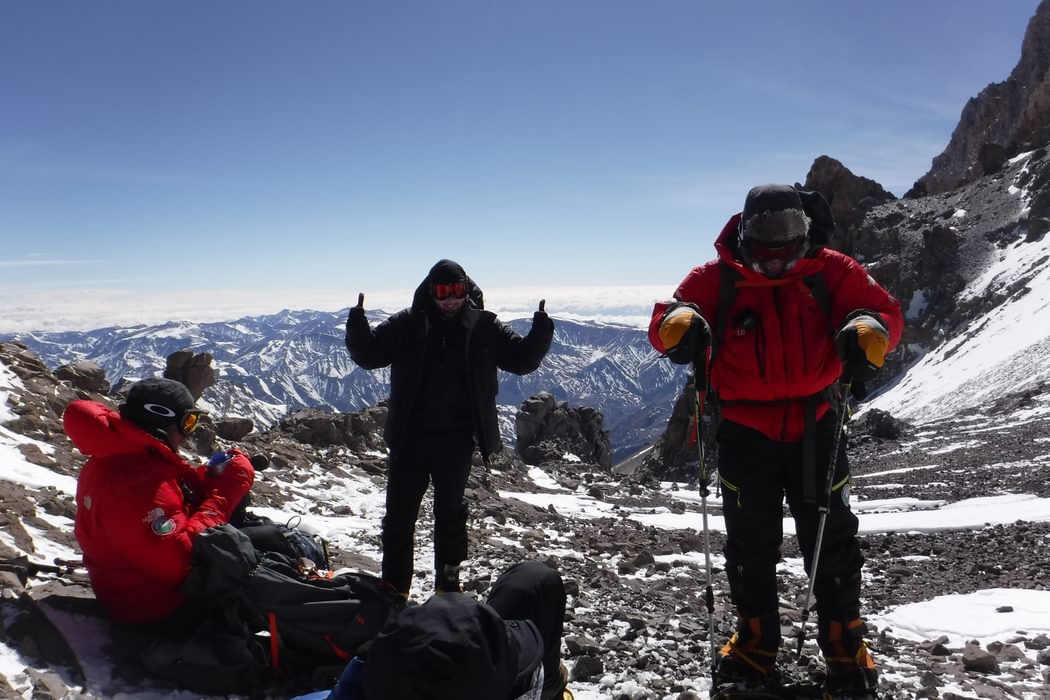
The team settled into a steady plod as we progressed towards our goal. After about an hour a large team descended towards us, followed by others. They had got too cold and, worried about their fingers and toes, they'd turned around. A small wave of relief came over me: an earlier start wouldn't have been useful. But the worry soon returned: would we also get too cold? Would people tell me if their toes had gone numb? When would the winds strengthen? If a storm was coming, would we have enough warning to get back to the safety of our camp in time?
We continued, the team now stretched out, members finding their own pace. We passed the rarely used Independencia Camp and carried on to Windy Col above. A long traverse past a finger of shattered rock gave a reprieve from the ascent before the route began to gain altitude again. The innocuous-looking ascent to The Cave is particularly tough.
La Cueva, at 6650m, is high up, but is not the summit. On arriving at this relatively flat, sheltered spot team members slumped to the ground, but the infamous Canaleta still lay ahead. This year, full of snow, the Canaleta was not the obstacle it can be, but was definitely not a place to slip. The Cave was the high point for two members of our team, who had pushed themselves far enough. As I needed to ensure they could get themselves back down a local guide, Ilan, and I continued with the four remaining team members whilst Mauri descended with the others.
The weather was holding but we couldn't move any faster: we just hoped that it would stay fine.
It did, and we did. Finally six of us stood on the summit, looking across the High Andes below us.
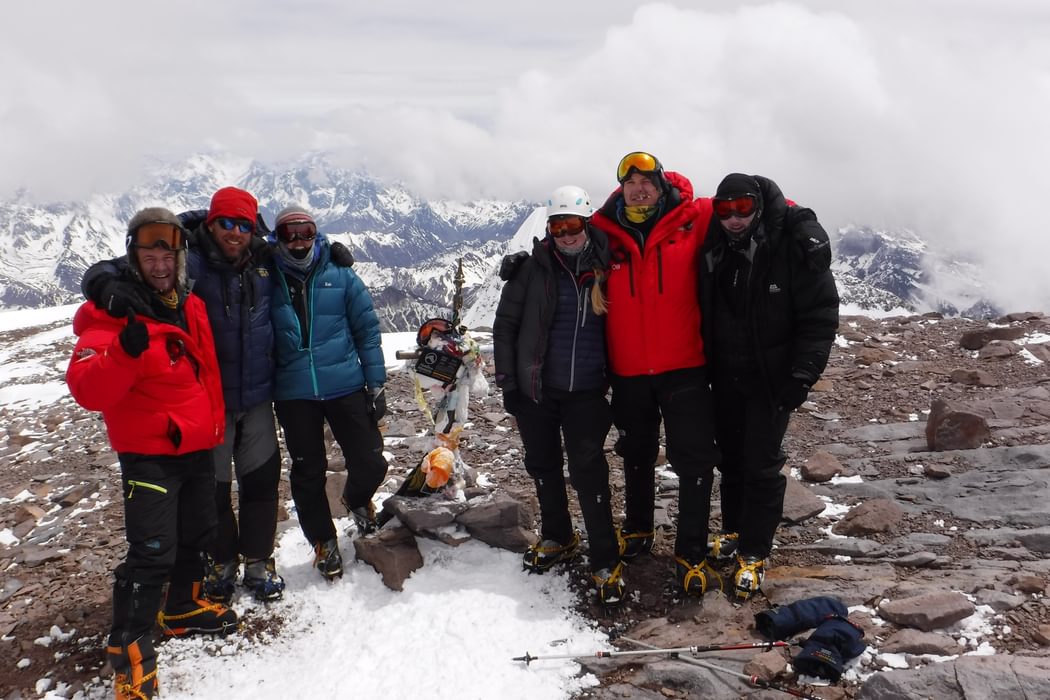
To read more articles like this get our newsletter
Sign up for 20% off your next purchase and to be the first to hear about exclusive competitions, special offers, and news from Cicerone.







